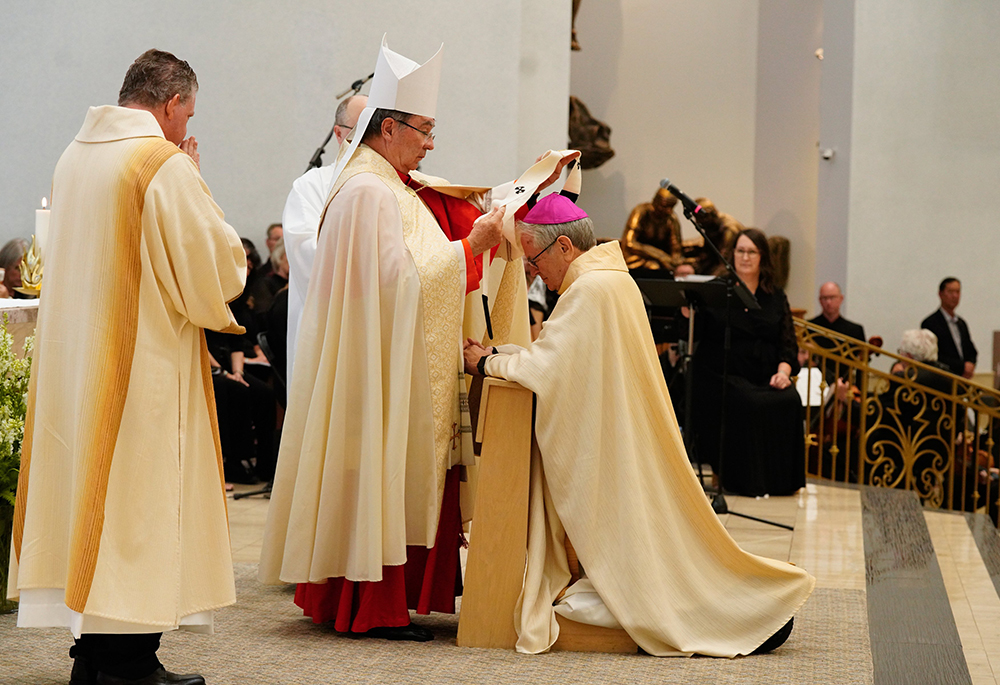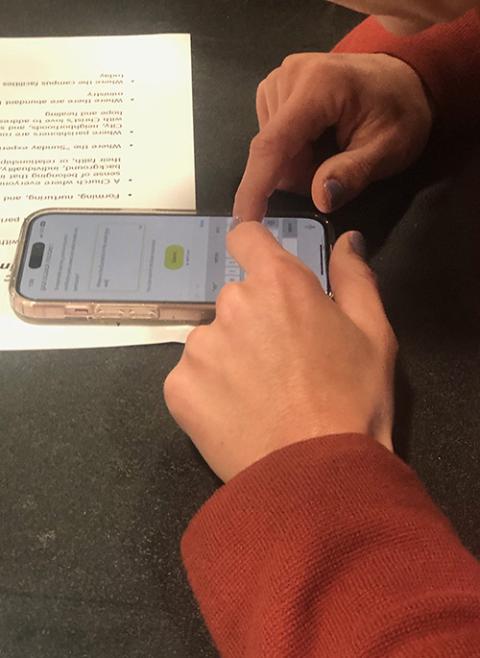
Cardinal Christophe Pierre, nuncio to the U.S., vests Las Vegas Archbishop George Leo Thomas with the Pallium during a Mass for elevating the Diocese of Las Vegas to an archdiocese at the Shrine of the Most Holy Redeemer Oct. 16, 2023, in Las Vegas. (OSV News/ Archdiocese of Las Vegas/Robin Jerstad)
They have a big problem in the Baltimore Archdiocese. Plans were announced to reduce the number of parishes in the historic see city from 61 to 21.
They have a different problem in the Archdiocese of Las Vegas. The confirmation class at the Church of St. Anne was over 230, and so they had to move the April 10 celebration of that sacrament to the Shrine of the Most Holy Redeemer, the largest church in the city.
The parish consolidations in the oldest diocese in the country are evidence of a shrinking church in a shrinking city. The entry for Baltimore in the 1970 edition of Compton's Encyclopedia with which I grew up begins: "Baltimore, Md. The sixth largest city in the United States is Baltimore." Today, it is the 31st largest city in the country, its population having shrunk 1.17% just last year.

A participant prepares to vote and comment in real time via cellphone at the third modeling session for the Baltimore Archdiocese's Seek the City parish planning process March 22 at Our Lady of Victory in Arbutus, a Baltimore suburb. (OSV News/Catholic Review/Christopher Gunty)
The recent Pew Research survey numbers show that the Catholic population has remained at around 20% since 2014, after dropping off from 24% at around the turn of the century. Catholicism is still the largest denomination in the country, but the ethnic and geographic distribution of the Catholic population has changed. Now 29% of all Catholics in the U.S. live in the South and 24% live in the West. Only 26% live in the Northeast and even fewer, 21%, live in the Midwest.
The cardinalatial sees of the early and mid-20th century were all in the Northeast and Midwest: Boston, New York, Philadelphia, Baltimore, Detroit, St. Louis and Chicago. The first U.S. cardinal beyond these two regions was Los Angeles' archbishop Cardinal James McIntyre, who was raised to the sacred purple in 1953. Incidentally, McIntyre was not only a priest from New York, but had been coadjutor archbishop of New York before being sent to Los Angeles in 1948.
When Pope Francis named a new bishop to the Diocese of Charlotte, North Carolina, on April 9, the press release from the U.S. bishops' conference noted that the diocese that covers the western half of North Carolina now has 546,370 Catholics. Last year, when Pope Francis elevated Archbishop Christopher Coyne to become coadjutor archbishop of Hartford, Connecticut, the press release noted the archdiocese is home to 427,669 Catholics. North Carolina, the heart of the Bible Belt and home to the Rev. Billy Graham, is now home to more Catholics than all but a handful of dioceses in the Northeast.
People sing and dance during a Eucharistic procession in Charlotte, North Carolina, Sept. 9, 2023. The procession covered nearly a mile and included dozens of clergy, men and women religious, and people of all ages and backgrounds, some walking in silence while others strolled behind parish banners, singing, dancing, playing music and praying the rosary. (OSV News/Catholic News Herald/Patrick Schneider)
Las Vegas Archbishop George Thomas told me that St. Anne's Church, which had to move its confirmation ceremony, holds nine standing-room only Masses each weekend. The archdiocese has seven building projects underway. Two parishes have more than 40,000 registered parishioners. "People come to Vegas, but once you get to Las Vegas, you find a faith-filled, family-oriented community," Thomas told me. He also cited the local church's intentional efforts to cultivate lay leaders, especially in the Hispanic community: "The collaboration of laity working with their pastors has set the church on fire with the Holy Spirit."
The future of the Catholic Church in this country requires intentional focus on the Latino and other immigrant populations. A 2014 Pew survey found that nearly a quarter of all Hispanics were former Catholics. Some have joined Protestant congregations, especially evangelical and Pentecostal groups which set up storefront churches in Hispanic neighborhoods. Others, especially second- and third-generation Hispanic Catholics, follow the path of secularization their Anglo co-religionists have trod. There is no more pressing challenge facing the Catholic Church in this country than helping our Latino, Caribbean, African, Asian and European Catholic immigrants not assimilate into the mainstream, secular culture.
Americans have long been more religious than Western Europeans but we are catching up fast. A Pew survey from 2009 offered a variety of reasons why people left the Catholic Church. Many cited the church's teachings on birth control and other issues, made possible by a severe lack of catechesis. Among those who left Catholicism for an evangelical church, 78% said "their spiritual needs" were "not being met." Many people grew disenchanted with the Catholic Church because of the clergy sex abuse crisis.
Advertisement
I believe the main reasons why people leave the Catholic Church are different from those discussed in the Pew surveys. I believe the agents of secularization are affluence and busyness. Jesus announced his ministry (Luke 4) by saying he came "to bring good news to the poor," and we are no longer poor. The Lord promised to be close to the brokenhearted (Psalm 34), not to the self-sufficient. Jesus offers the model of radical obedience to the will of his Father and we prize our autonomy above all else. Our American culture prizes success and we worship a crucified God.
And, we are busy, busy, busy. Since the demise of blue laws, many people have to work on Sundays. Some people have become addicted to the Times crossword puzzle. Some need to bring the kids to soccer practice. Our grandparents may or may not have complained about a pastor who preached badly, but they had no alternatives on Sunday morning. Today, if we bring our kids to a boring sermon week-on and week-out, or the parish has no means for engaging young people, why should we be surprised when those kids want to be elsewhere?
Only a privatized faith can survive in such a culture and Catholicism, once privatized, quickly finds itself in decline. Catholicism needs to generate culture. The power of the Christian faith, manifested in suffering, prayer, obedience, may not capture headlines or clicks, but it is that power which moves silently and unseen, even in a spiritually barren landscape like our own secularized culture. If it is to bear fruit, those of us still in the church need to listen to the Spirit, not to ourselves, and follow wherever the Spirit leads.
The difficult news is not that the church is in decline. The difficult news is that its rebirth requires us to embrace Calvary, not to shun it, and we have so much else to do.








